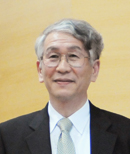DG's Corner
New Year's Resolution 2011
05 Jan 2011

Atsuto Suzuki
Director General
Happy New Year to everyone. I would like to talk about my plans for this year.
Last year was the year of the Tiger. I mentioned that the forecast for the year would be "sunny and then cloudy and then sunny," just like the alternating stripes of a tiger. We can summarize the year as follows:
- February: Neutrinos from J-PARC were observed at Super-Kamiokande (T2K experiment)
- March: World record of 500kV was reached by the DC Electron Injector for the next generation light source.
- March: Produced pulsed muon beam of world record intensity
- March: LHC succeed with the 7 TeV collision at CERN. Long-awaited stable beam commissioning started.
- June: KEKB upgrading was acknowledged as one of the "cutting-edge research infrastructure projects"
- September: SuperKEKB receives an official grant from by the Science and Technology Council.
- November: Japan-made 9-cell superconducting RF cavity met the specification for ILC for the first time.
- December: Ex KEK Director Professor Nishikawa passed away.
- December: Japan-USA Scientific Collaboration Agreement is revived.
As you can see, my prediction was not quite correct, as things did not occur in an alternating fashion like the stripes of a tiger.
Now let's take a look at the present situation in Japan. Accelerator science projects are becoming gigantic not only in the elementary particle physics/nuclear science field, but also in the materials structure/life science fields that utilize synchrotron radiation, neutrons and muons. Obviously, this trend is going to continue not only in accelerator-related science but other fields as well. For the accelerator sciences to survive, we need strong taxpayer support. Impressive results in research and education must also be achieved. Moreover, we also need to feed technological breakthroughs back into society. The Advanced Accelerator Association Promoting Science & Technology (AAA), established in 2008, is an amalgam of government ministries, industries and universities. The Association aims to broaden human intellectual horizons in the fields of space, elementary particles, material and life science, and to undertake global-level assignments on medical, energy and environment issues by facilitating industry-government-academia collaboration and seeking a range of industrial applications of advanced accelerators and technologies derived from R&D on advanced accelerators. As of now, 38 universities and approximately 100 companies are involved. With the active participation of members, the association has been doing quite well.
However, there is a limit to what they can do. To promote accelerator-related science further, we have to have a long-range strategy that includes not only scientific research but also the development of accelerator technologies and their industrial applications.
Unfortunately, neither the government nor the funding agency MEXT (Ministry of Education, Culture, Sports, Science and Technology) have a structure that allows them to integrate such long-term strategies extending to such a wide range of areas. MEXT has projects such as "space-related R&D and its applications", "R&D on nuclear power", "R&D on ocean resources and the Antarctic region" as the "mainstream for future scientific and technological development". They spelled out that "mega-science projects on nuclear power, space, the oceans and so forth have been national projects coming under the Science and Technology Agency since the mid 1950s. Accelerator-related science has been promoted through universities and inter-university research organizations supported by the government. However, considering the size of the projects, it is of the utmost importance to make it a long-range national project for the next, five, ten or twenty years. We are working for the establishment of a government structure that will allow the inclusion of accelerator-related science in the list of national projects.
Now I would like to address global issues. As I mentioned in my "DG's Corner", we must make accelerator-related projects more global in nature. We expect there will be further escalation in project size, budgets and project period. To find solutions to all these problems, a single laboratory globally simply will not work. We should globalize in such a way that research can be carried out in various locations around the world, while maintaining a close network so that research efforts can be unified. We need to find out how this can be achieved. The world is struggling to find a scheme to realize globalization in this area of endeavor. An international working group has made a proposal on a multi-national lab. The plan can be summarized as follows:
- A representative from each country/region will establish an office in the central host laboratory to manage and operate the multi-national laboratory
- Human resources (researcher, engineer, administrator), budgets and in-kind resources will be shared by the member countries or laboratories. The amount of contribution will be determined for each stage of development (construction, preparation, operating) taking the situation into consideration.
- Conditions of employment (salary, insurance, retirement fund, etc.) will comply with the rules and regulations of the member country.
- While all the member countries/laboratories are treated equally in terms of their participation, each should provide contributions appropriate to their standing, take responsibility and have rights regarding construction and operation.
This concept was accepted by the ILCSC last July and will be applied to the preparatory laboratory for ILC. It is considered to be appropriate for the Compact ILC (CLIC) and Muon Collider. This concept will be further developed this year.
In closing, I would like to refer the signs of the zodiac as usual. This is the year of the rabbit. A proverb related to the rabbit says: "If you run after two hares, you will catch neither."
This illustrates a potential problem for a multi-project lab such as KEK. However, I should point out that the proverb assumes that the hunter was chasing two hares using a technique suitable for catching only one. So, the outcome is obvious. We will be different. We plan well so that we will catch them both at the same time.